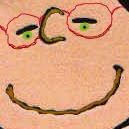A. Menu bar - the menu bar contains menus for performing tasks. The menus are organized by topic. For example, the Layers menu contains commands for working with layers.
B. Options bar – the options bar provides options for using a tool. (See Using the options bar.)
C. Toolbox - the toolbox holds tools for creating and editing images.
D. Palette well - the palette well helps you organize the palettes in your work area.
E. Palettes - palettes help you monitor and modify images.

The Options Bar
Most tools have options that are displayed in the options bar. The options bar is context sensitive and changes as different tools are selected. Some settings in the options bar are common to several tools (such as painting modes and opacity), and some are specific to one tool (such as the Auto Erase setting for the Pencil tool).
You can move the options bar anywhere in the work area using the gripper bar, and dock it at the top or bottom of the screen. Tool tips appear when you hold the pointer over a tool.
Click on the paint brush to see the options bar change. With the paint brush selected you get special options that effect only the paint brush – like opacity and brush size. Most tools come with special features to modify the behavior of the tool – look for them here in the options bar.
The Palettes
Palettes help you monitor and modify images. You can choose which palettes are visible. By default, palettes appear stacked together in groups. You can move palette groups, rearrange palettes in their groups, and remove palettes from groups.
- To display a palette menu, position the pointer on the triangle in the upper right corner of the palette, and press the mouse button.
- Some palettes, like History and Layers, have a series of buttons on the bottom of the palette – most importantly, the trash can.
The Toolbox

You select a tool by clicking its icon in the toolbox. A small triangle at the lower right of a tool icon indicates hidden tools. Positioning the pointer over a tool displays a tool tip with the tool's name and keyboard shortcut.
A. The marquee tools make rectangular, elliptical, single row, and single column selections.
B. The Move tool moves selections, layers, and guides.
C. The lasso tools make freehand, polygonal (straight-edged), and magnetic (snap-to) selections.
D. The Magic Wand tool selects similarly colored areas.
E. The Crop tool trims images.
F. The Slice tool creates slices.
G. The Slice Select tool selects slices.
H. The Healing Brush tool paints with a sample or pattern to repair imperfections in a image.
I. The Patch tool repairs imperfections in a selected area of an image using a sample or pattern.
J. The Color Replacement tool replaces a selected color with a new color.
K. The Brush tool paints brush strokes.
L. The Pencil tool paints hard-edged strokes.
M. The Clone Stamp tool paints with a sample of an image
N. The Pattern Stamp tool paints with part of an image as a pattern.
O. The History Brush tool paints a copy of the selected state or snapshot into the current image window.
P. The Art History brush tool paints with stylized strokes that simulate the look of different paint styles, using a selected state or snapshot.
Q. The Eraser tool erases pixels and restores parts of an image to a previously saved state.
R. The Background Eraser tool erases areas to transparency by dragging.
S. The Magic Eraser tool erases solid-colored areas to transparency with a single click.
T. The gradient tools create straight-line, radial, angle, reflected, and diamond blends between colors.
U. The Paint Bucket tool fills similarly colored areas with the foreground color.
V. The Blur tool blurs hard edges in an image.
W. The Sharpen tool sharpens soft edges in an image.
X. The Smudge tool smudges data in an image.
Y. The Dodge tool lightens areas in an image.
Z. The Burn tool darkens areas in an image.
AA. The Sponge tool changes the color saturation of an area.
BB. The path selection tools make shape or segment selections showing anchor points, direction lines, and direction points.
CC. The type tools create type on an image.
DD. The type mask tools create a selection in the shape of type.
EE. The pen tools* let you draw smooth-edged paths.
FF. The Custom Shape tool makes customized shapes selected from a custom shape list.
GG. The annotation tools make notes and audio annotations that can be attached to an image.
HH. The Eyedropper tool samples colors in an image.
II. The Measure tool measures distances, locations, and angles.
JJ. The Hand tool moves an image within its window.
KK. The Zoom tool magnifies and reduces the view of an image.
LL. Foreground and Background colors

No comments:
Post a Comment